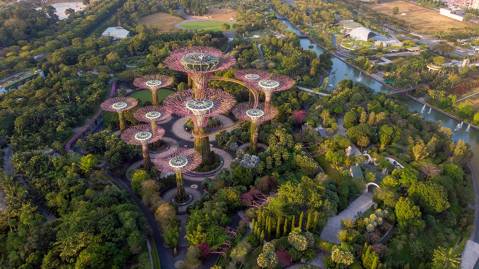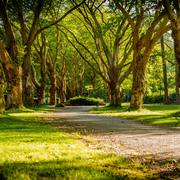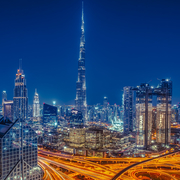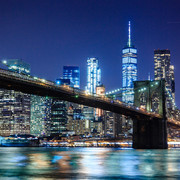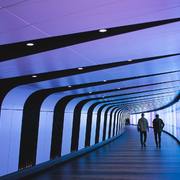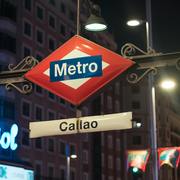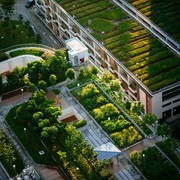Singapore and vertical green buildings
Throughout history, the world's population has lived in general in rural areas. In the 19th century, at least 90% of the world's population lived in the countryside, while the urban population made up less than 10%. With the development of trade, people changed that lifestyle, drifting into urban life as cities became nuclei of commerce. As industrial production became widespread, migration multiplied and people moved to areas with more production, establishing new and large settlements. Con the Third Industrial Revolution, rapid urbanization began and today, 54% of the world's population lives in cities. By 2050, the world's urban population is projected to increase to 66%. That's when we ask ourselves, should we give up our connection to nature in the future?
At the heart of mass migration is the need to seek a comfortable life in which we have the greatest facilities in transport, communication, education and salud as a priority. This puts pressure on the area people migrate to, as resources are limited, but the number of people looking to take advantage of them increases every day. While cities offer people the opportunity to live a more comfortable life, they at the same time create local, regional and universal problems that are difficult to solve.
Population growth and rising income levels are another source of debate. The forecasts point to continued growth in the world's population so that by 2060, humanity would overcome the barrier of the 10 billion inhabitants on planet Earth. Thispopulation growth is undoubtedly puttingstrong pressure on the environment.
Today, cities consume 75% of the world's natural resources and are responsible for 50% of the waste generated,while producing, on average, 70% of the world's greenhouse gas emissions. Of course, cities must address needs such as food, housing, clean air, water and waste collection services, but they must also provide green spaces where citizens can go to be healthy, take a break and cool off.
Singapore, transforming a city into a sustainable garden
With only 700 square kilometers, but inhabited by more than 5.7 million people, Singapore is the second most densely populated country on the planet, behind only Monaco, which has only 40,000 citizens. Today, Singapore isconstituid or bya number of parks and green spaces. The vegetation is born naturally on the ground but, today, it reaches the top of much of its architecture, growing even on the terraces, houses, offices.. . But it hasn't always been like this.
Today, this city-state is an extraordinary lesson for the rest of the world on how to perfectly combine urban life with nature. The perfect combination that we seek all those who are dedicated to real estate. Since the British first colonized it in 1819 and Singapore was formally founded as a country,more than95% of the island's vegetation has been cut down. The speed at which this state grew, both in terms of infrastructure and population, was so rapid that it lost its flora and fauna at a different rate than any other nation.
With 90%of its forests, 67%of its native bird species and 40%of its mammals lost to the rapid growth of the city, it became clear that the level of industrialization was no longer sustainable. In 1967, two years after Singapore became independent, plans were launched to transform the nation into a 'gardencity',designating land to be converted into nature reserves.
But green spaces weren't the only problem the city faced. Air pollution was becoming a growing problem, to the pointthat, in 1996, the country had one of the highest emissions levels on the planet. In the early 1990s, the Singapore Green Plan (GSP) was created and, ten years later, in 2002, it was re-established as the 2012GSP,which focusedon three key areas:
- Air and climate change
- Water and clean land
- Nature and public health
The objective ofthis plan was to correct the problems facing Singapore in 2012 through educational outreach activities, awareness campaigns and infrastructure changes. A large part of this plan had to do with the recovery of green spaces and the search for innovative ways to revitalize the city, which is how Singapore has become known as a 'biphilic' city.
Biphilic Cities
The word 'biophysical' means 'lovefor nature and the naturalworld',and provijan of the conjunction of the terms bio- (life) and -filia (friendly). Currently, thereis an organization called Biophilic Cities that works with cities around the world to achieve an accredited status and with recognition for their work, which manages to combine nature in urban planning.
"These partner cities are working on concerts to conserve and celebrate nature in all its forms [...] from biodiversity to the wild urban spaces present in cities," his website explains.
"We recognize the importance of daily contact with nature as an element of meaningful urban life, as well as the ethical responsibilityof cities to preserve global nature as a shared habitat for non-human life andpeople."
Singapore has been a member of Biophysical Cities since 2013, no doubt thanks to the work done across the country to revitalize the island. Much of this regeneration in Singapore was led by Dr. Cheong Koon Hean, who led the nation's urban development agency. Part of his jobwas to implement an incentive program to encourage construction companies and owners to install rooftop gardens and vertical plant walls.
Since 2009, this plan has modernized more than 100 buildings with green roofs, urban orchards,rooftop recreation gardens and green natural walls. Thishas not only helped to improve the city from an ecological perspective, but has also established Singapore's unique and distinctive aesthetic. This additional vegetation has helped mitigate the effect of urban heat, while improving air quality, as plants act as purifiers and air filters.
Cheong expects Singapore to remain green, both in terms of construction efficiency and by incorporating vegetation into its designs. But he also believes it can serve as a model for other cities to learn. "Manycities, especially those in Asia, are densely populated,"he said in a National Geographic interview, "butour experience shows that those cities can be habitable."
The importance of a global change of perspective
In many countries, short-term approaches have prioritized economic development over theenvironment, but today a change of mindset is needed. Countries must learn from Singapore, betting on city is habitableand sustainable through a pragmatic policy, based on sound economic and scientific principles, a long-term planning approach and effective implementation and the ability to achieve citizens' support through the public interest.
To do this, measuressuch as the integration of sustainable infrastructures and the increaseof green spaces in thecity arenecessary, as stipulated in the UN Sustainable Development Goals. For example, reducing the negative environmental impact of cities per capita: the presence of trees and green areas contributes to the reduction of carbon dioxide emissions into the atmosphere and the effects of the urban heat island.
One of Singapore's main strengths in following this line of action in the future is the environmental awareness of its citizens. For Lim Liang Jim, director of the National Biodiversity Center of the National Parks Board, educating young people is critical to maintaining the achievements achieved in the country:"Ifin the futuresomeone says 'let's not think green, let's build', a significant part of the population will act as informed advocates ofthe conservation of nature and greenspaces."
Many cities are densely populated. Singapore's transformation showsthat these cities can be habitable. A direct and precise focus on equitable access to comforts and commitment to affordable housing would provide a solid foundation for a stable society. The involvement of governments and public institutions, the use of technology and public-private partnerships are fundamental to achieving this objective. Singapore stands out today as an example of how we can make our own cities truly green.
